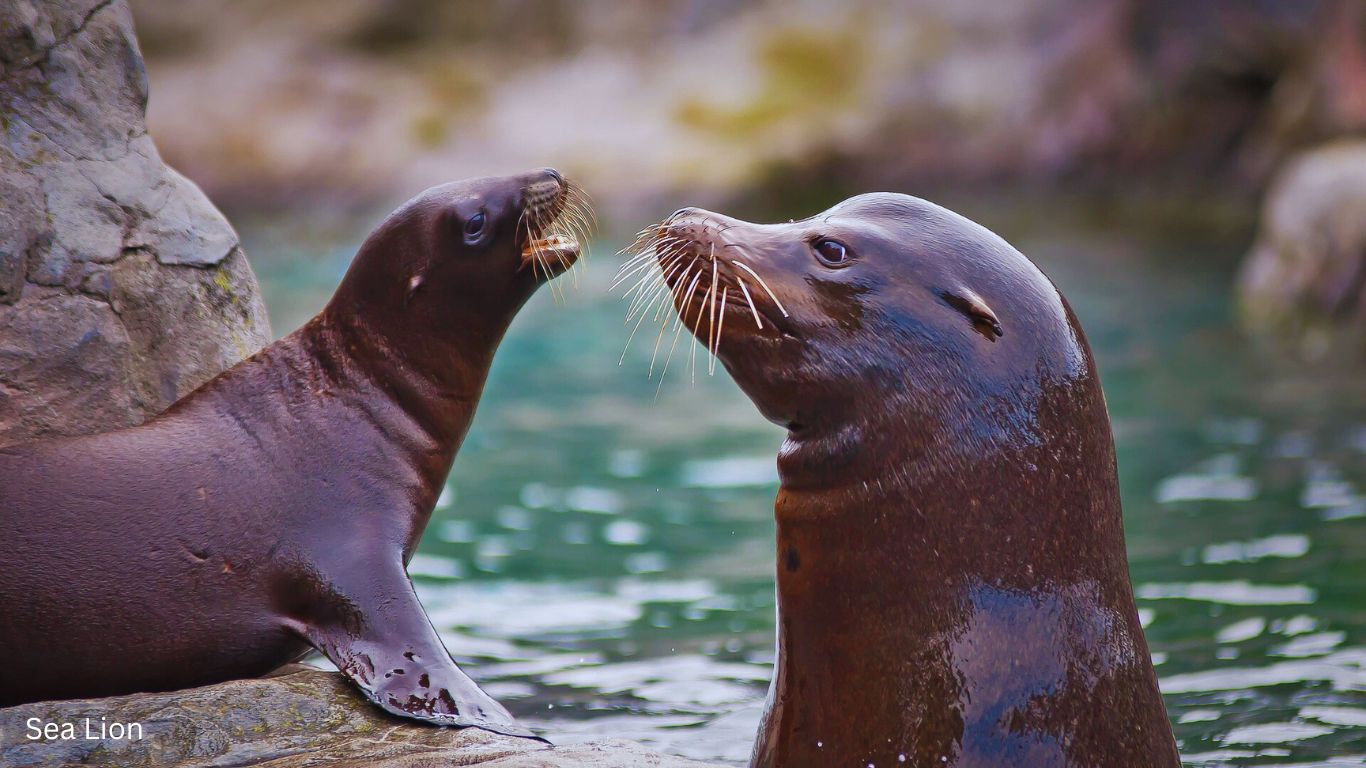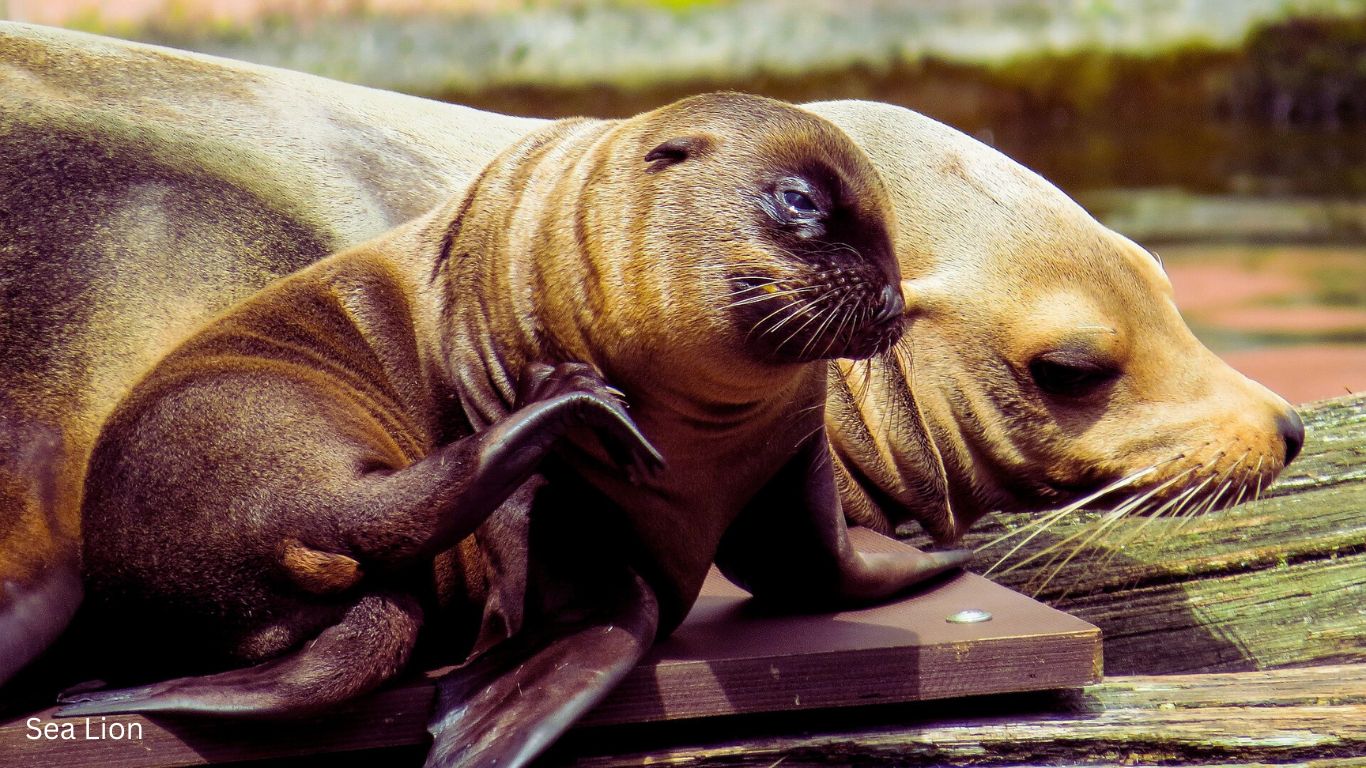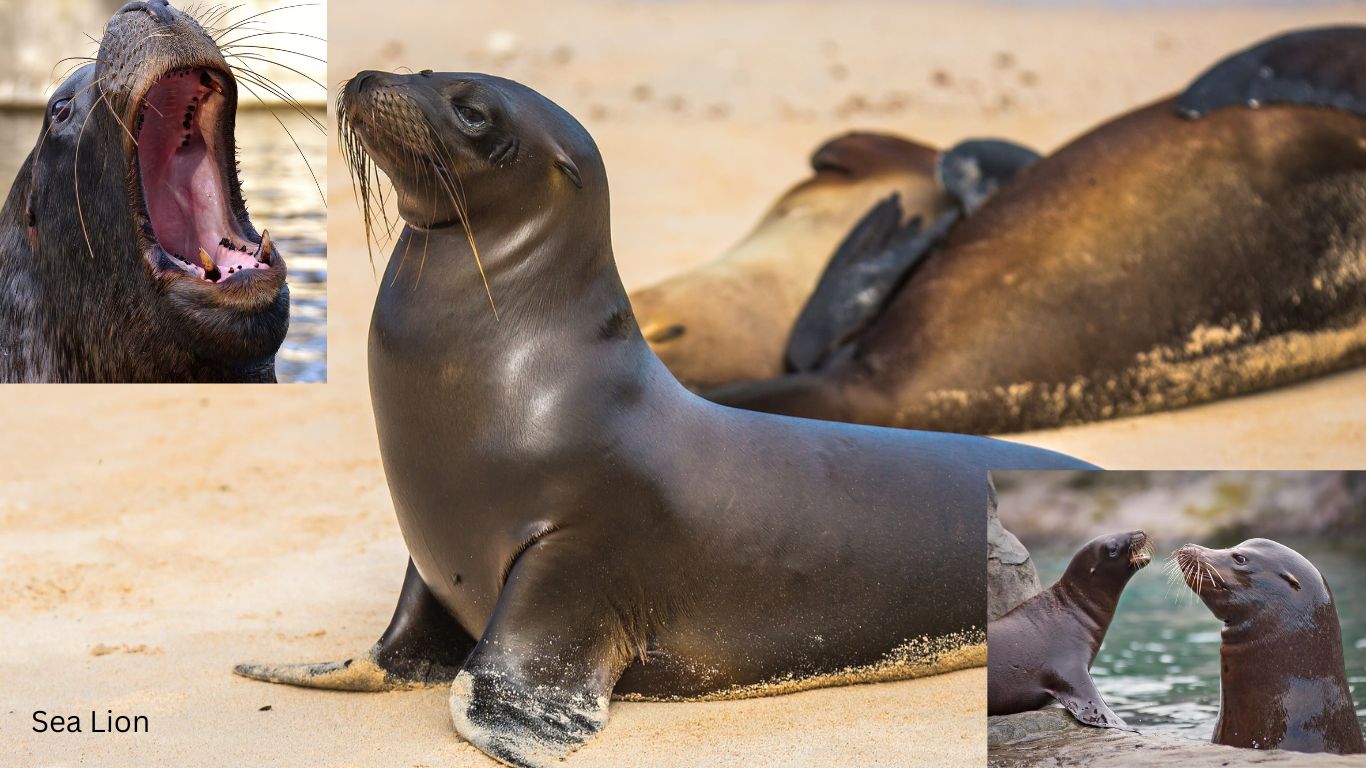Sea Lions – Introduction
Sea lions are captivating marine mammals that belong to the family Otariidae, commonly known as pinnipeds. These sleek and agile creatures are renowned for their unique adaptations to both land and water. With their remarkable swimming abilities and social behaviors, sea lions have intrigued humans for centuries. In this exploration, we delve into the world of sea lions, unraveling their captivating traits and shedding light on their ecological significance.

Within the animal kingdom, sea lions are classified under the order Carnivora and the suborder Pinnipedia, which also includes seals and walruses. They are distinct from true seals due to their external ear flaps and the ability to rotate their hind flippers forward, enabling efficient locomotion on land. This classification places sea lions as part of a diverse group of marine mammals, each with its own set of adaptations for surviving in aquatic environments.
Physical Characteristics
Here below are some physical characteristics of sea lions.

A. Size and weight variations among different sea lion species
Sea lions exhibit a range of sizes and weights across different species. While specifics may vary, adult males are generally larger than females. For example, the California sea lion (Zalophus californianus) males can reach lengths of 7 to 8 feet (2.1 to 2.4 meters) and weigh around 600 to 800 pounds (270 to 360 kilograms). In contrast, females typically measure 5 to 6 feet (1.5 to 1.8 meters) and weigh around 200 to 250 pounds (90 to 113 kilograms). Other species, such as the Steller sea lion (Eumetopias jubatus), can be even larger, with males reaching lengths of up to 11 feet (3.3 meters) and weighing around 2,000 pounds (907 kilograms).
B. Streamlined bodies and adaptations for aquatic life
Sea lions possess sleek and streamlined bodies that are perfectly adapted for life in the water. Their streamlined shape, along with their strong forelimbs modified into flippers, allows them to swim with agility and speed. These adaptations enable sea lions to navigate through the ocean with remarkable efficiency, making them skilled hunters in pursuit of their underwater prey.
C. Notable features, such as their external ear flaps and long whiskers
One distinctive feature of sea lions is their external ear flaps, also known as pinnae, which distinguish them from true seals. These ear flaps are visible on the sides of their heads and aid in their hearing abilities both in water and on land. Another striking characteristic is their long whiskers, called vibrissae, which are highly sensitive tactile hairs. These whiskers help sea lions detect vibrations in the water, allowing them to locate prey and navigate their environment.
D. Pelage and coloration variations across different species
Sea lion pelage, or fur, varies among species and can also change in color and pattern with age and sex. Generally, sea lions have short, coarse fur that helps streamline their bodies while swimming. Colors range from light to dark brown, and some species may have patches of lighter or darker fur. For example, adult male California sea lions have a dark brown to black coloration, while females and juveniles display a lighter brown hue. These variations in pelage and coloration contribute to the visual diversity observed among sea lion species.
Habitat and Distribution
Sea lions primarily inhabit coastal areas and islands, selecting habitats that provide suitable conditions for their survival. They can be found along the coastlines of various continents, including North and South America, Africa, Australia, and Asia. These marine mammals are well-adapted to both rocky and sandy shores, often utilizing caves, rocky outcrops, and beaches for resting, breeding, and rearing their young. Additionally, sea lions show a preference for islands, which can offer protection from predators and human disturbance.

A. Geographic distribution across different regions
Sea lions have a wide geographic distribution, with different species occupying specific regions. Some notable examples include the California sea lion found along the western coast of North America, from Alaska to Mexico, and the South American sea lion, which is prevalent along the Pacific coast of South America, from Peru to the Falkland Islands. The Steller sea lion is found in the northern Pacific Ocean, with populations in the waters of Alaska, Russia, and Japan. Other species, such as the Australian sea lion and New Zealand sea lion, have more localized distributions.
B. Locations known for sea lion populations
Various locations around the world are known for their significant sea lion populations. For instance, the Galapagos Islands in the Pacific Ocean are home to the Galapagos sea lion, a unique subspecies endemic to the region. The Channel Islands off the coast of California also host a thriving population of California sea lions. In South America, the Islas Ballestas in Peru and the Peninsula Valdes in Argentina are renowned for their colonies of South American sea lions. The Sea of Okhotsk in Russia is an important habitat for Steller sea lions. These are just a few examples of the specific locations where sea lions can be found, highlighting the diverse range of habitats they inhabit across the globe.
Behavior and Social Structure
Sea lions are highly social animals and often form large colonies, especially during the breeding season. These colonies can range in size from a few individuals to several thousand, depending on the species and the availability of suitable habitats. Within these colonies, sea lions exhibit complex social interactions, including communication, mating rituals, and cooperative behaviors. They establish social hierarchies, with dominant males typically defending territories and breeding rights.

A. Their feeding habits and diet, primarily consisting of fish and squid
Sea lions are opportunistic predators with a diverse diet primarily consisting of fish and squid. They are skilled hunters, using their streamlined bodies and powerful flippers to navigate through the water and capture their prey. Sea lions are capable of diving to considerable depths, often reaching depths of several hundred feet in search of food. They have sharp teeth and strong jaws that allow them to efficiently catch and consume their prey underwater.
B. Communication and vocalizations used by sea lions
Sea lions communicate with one another through various vocalizations, body postures, and visual displays. Vocalizations include barks, growls, and roars, which serve as means of establishing territory, expressing aggression, attracting mates, and maintaining social bonds within the colony. Additionally, sea lions use body language, such as head bobbing, flipper movements, and facial expressions, to convey messages and maintain social cohesion.
C. Sea Lions breeding behavior, including mating rituals and pup rearing
Breeding behavior among sea lions is characterized by elaborate rituals and displays. Dominant males establish territories and engage in fierce competition to secure breeding rights with females. Mating rituals can involve vocalizations, posturing, and physical displays of strength. Once a female is impregnated, she typically gives birth to a single pup, which she nurtures and protects. Pup rearing involves the mother providing milk and teaching her offspring essential survival skills, such as swimming and hunting. The bond between mother and pup is strong and critical for the pup’s early development and survival.
Conservation Status and Threats
The conservation status of sea lions varies among species, but overall, many populations of sea lions are facing conservation concerns. Some species, such as the Steller sea lion, are listed as “near threatened” or “endangered” by the International Union for Conservation of Nature (IUCN). Other species, like the California sea lion, are considered to be of “least concern” due to relatively stable populations. However, it is important to monitor and manage all sea lion populations to ensure their long-term survival.

A. Threats faced by sea lions, such as habitat loss and pollution
Sea lions face various threats that jeopardize their populations. Habitat loss and degradation, primarily caused by coastal development, can limit their access to suitable breeding and resting areas. Pollution, including marine debris and oil spills, can have detrimental effects on their health and overall well-being. Overfishing and depletion of fish stocks also impact sea lions’ food sources, affecting their ability to thrive. Additionally, entanglement in fishing gear and conflicts with fisheries pose significant risks.
B. Conservation efforts and initiatives aimed at protecting sea lions
To safeguard sea lion populations, numerous conservation efforts and initiatives have been established. These include protected areas and marine reserves that provide safe habitats for sea lions. Conservation organizations and governmental agencies work to monitor populations, conduct research, and implement management strategies to mitigate threats. Efforts are also focused on educating the public about responsible wildlife interactions and promoting sustainable fishing practices. Collaborative conservation projects and public participation play crucial roles in the conservation of sea lions, aiming to ensure their survival and the preservation of their habitats.
Interactions with Humans
Sea lions have held cultural significance for various societies throughout history. In many indigenous cultures, they are revered as symbols of wisdom, strength, and guardianship. Their presence in myths, folklore, and artwork showcases the deep connection between humans and these majestic marine mammals. Sea lions have also been used in traditional practices, such as hunting and ceremonial rituals, underscoring their historical importance to human communities.
A. Human activities that may impact sea lion populations, such as fishing
Human activities can have both positive and negative impacts on sea lion populations. Fishing practices, especially overfishing and bycatch, can directly affect sea lions by depleting their food sources or causing entanglement in fishing gear. Competition for resources and conflicts with fisheries can further threaten their populations. It is crucial to implement sustainable fishing practices and establish regulations that consider the needs of sea lions and other marine species.
B. Wildlife tourism and guidelines for observing sea lions in the wild
Wildlife tourism centered around sea lions has gained popularity in many coastal regions. Responsible wildlife tourism practices prioritize the well-being of sea lions and their natural habitats. Guidelines for observing sea lions in the wild often include maintaining a safe distance to avoid disturbance, refraining from feeding or touching them, and respecting their natural behaviors. By following these guidelines and supporting ethical operators, visitors can enjoy memorable experiences while minimizing the impact on sea lions and their ecosystems.
Promoting awareness and understanding of the ecological importance of sea lions and fostering a harmonious relationship between humans and these magnificent creatures is essential for their conservation and the preservation of their habitats.
Notable Sea Lion Species
Several sea lion species have garnered attention due to their distinct characteristics and ecological significance. Two notable examples are the California sea lion (Zalophus californianus) and the Steller sea lion (Eumetopias jubatus). The California sea lion is known for its agility, intelligence, and charismatic nature, making it a popular subject of marine research and wildlife tourism. The Steller sea lion, on the other hand, stands out for its massive size, commanding presence, and intriguing behaviors.

Unique characteristics and conservation status of each species
1. California sea lion (Zalophus californianus)
1. Unique Characteristics: California sea lions have sleek bodies, external ear flaps, and sharp teeth. They are highly vocal and renowned for their acrobatic displays both in water and on land. Males have a distinct crest on their forehead.
2. Conservation Status: The California sea lion is considered a species of “least concern” by the IUCN due to its relatively stable populations across its range. However, local populations may face threats from habitat degradation, pollution, entanglement, and disturbance caused by human activities.
2. Steller sea lion (Eumetopias jubatus)
1. Unique Characteristics: Steller sea lions are the largest of all sea lion species, with adult males reaching lengths of up to 11 feet (3.3 meters) and weighing around 2,000 pounds (907 kilograms). They have a robust build, thick fur, and a distinctive lion-like mane on the neck. Males also possess a strong, resonant vocalization known as “roaring.”2.
2. Conservation Status: The Steller sea lion is listed as “near threatened” by the IUCN. It has experienced population declines in some regions, particularly in the western part of its range. Threats include competition for food, entanglement in fishing gear, habitat degradation, and disturbances caused by human activities.
Understanding the unique characteristics and conservation status of these notable sea lion species provides insights into their ecological roles and the challenges they face. Conservation efforts focused on protecting their habitats, mitigating threats, and promoting responsible interactions with humans are vital for the long-term survival of these remarkable marine mammals.
Conclusion
Throughout this exploration of sea lions, we have delved into various aspects of their lives. We started with an introduction to sea lions, their classification within the animal kingdom, and their physical characteristics. We then examined their habitat and distribution, behavior and social structure, as well as their interactions with humans. Additionally, we highlighted notable sea lion species, including the California sea lion and the Steller sea lion, discussing their unique traits and conservation status.
It is evident that sea lions face numerous challenges in their natural environments. Habitat loss, pollution, overfishing, and human disturbances all pose threats to their populations. Therefore, it is crucial to emphasize the significance of conservation efforts aimed at protecting sea lions and their habitats. By implementing sustainable fishing practices, establishing protected areas, and promoting responsible wildlife tourism, we can contribute to the preservation of these magnificent creatures.
Sea lions play a vital role in the marine ecosystem as top predators. Their presence helps maintain the balance of marine food webs by regulating populations of prey species. Additionally, they contribute to the cultural heritage of various societies, holding a historical and symbolic significance. Recognizing their ecological importance and appreciating their cultural value strengthens our commitment to their conservation and underscores the need to protect their habitats.
As we strive to ensure the long-term survival of sea lions, let us continue to support conservation initiatives, foster responsible interactions, and promote sustainable practices. By doing so, we can safeguard these remarkable marine mammals and preserve the biodiversity and health of our oceans.
Are Seals Sea Lions: Can You Tell the Difference?


1 thought on “From Shore to Surf: The Extraordinary World of Sea Lions”